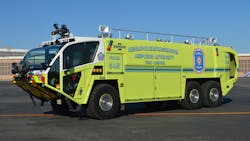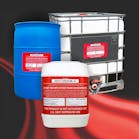The history of aircraft rescue firefighting (ARFF) vehicles can be traced back to 1937, when Chief J.K. Schmidt demonstrated the capabilities of a high-pressure fog appliance at Elgin Air Force Base in Florida under the auspices of the U.S. Army Corps of Engineers. Chief Schmidt modified a 750-gpm Peter Pirsch pumper, by replacing the hosebed with a 250-gallon water tank and using a high-pressure fog nozzle that was used by local citrus farmers. With these changes, Schmidt introduced the first apparatus specifically designed to combat aircraft and fuel fires.
ARFF history
Like many changes within the fire service, new technology was not immediately accepted. As commercial aircraft and airports were built and expanded, fire protection resources remained limited until the outbreak of World War II, when the military took the lead in providing adequate fire/rescue equipment to American assets around the world. During 1947, when the U.S. Air Force became a separate branch of the military, the emphasis on fire protection research and ARFF vehicles took center stage. Early Air Force pioneers in ARFF are credited with creating today’s ARFF apparatus design.
Over the years, several manufacturers have come to specialize in building ARFF vehicles, including American and Ward LaFrance, Maxim, and Walter Motor Truck, among others. Today’s modern ARFF vehicles look nothing like their predecessors, partly because they’ve become more multifunctional. Emergency One, KME, Oshkosh, Pierce and Rosenbauer are some of the companies that have engineered specialized apparatus for both civilian and military applications.
ARFF standards, design & use
There are several standards that govern the basic designs and capabilities of ARFF apparatus, including Federal Aviation Administration (FAA) circulars and National Fire Protection Association (NFPA) Standard 414: Standard for Aircraft Rescue and Firefighting Vehicles. Developing specifications for ARFF apparatus often depend on the source of funding for apparatus at municipal airfields, while each branch of the military develops their requirements based on assessments of installation needs and the size of airframes assigned to these locations. For these reasons, there’s a fair amount of standardization in the vehicle suppression systems and components, which enables personnel to safely operate a wide range of equipment.
Unlike structural fire apparatus utilized in the United States, ARFF vehicles are designed for use around the globe and have more of a European appearance. The Oshkosh Corporation introduced the Global Striker ARFF apparatus. This unit features extendable, high- reach turrets and is capable of holding up to 4,500 gallons of water. Several of these units are protecting Baltimore/Washington International, Dulles International and Regan National airports, and are equipped with 2,000-gpm pumps, 3,000 gallons of water 420 gallons of foam and 1,000 lbs. of dry chemical. These units also feature both bumper and roof monitors that are capable of producing flows up to 1,250 gpm.
A unique design
Municipal fire departments, such as the Truckee Fire Protection District (TFPD) in California, often maintain responsibility for airfield fire protection, Personnel at the TFPD worked with Rosenbauer to design a unique vehicle capable of both structural and airfield fire protection. Assigned to the Truckee/Tahoe Airport, TFPD Engine 96 features a 2015 International 7500 chassis equipped with a Rosenbauer rear-mounted, 1,250-gpm pump and a foam system with a 750-gallon water tank. The apparatus is further outfitted with remote-control monitors on the front bumper and left rear body corner, with a full complement of hydraulic rescue tools. The apparatus was specifically designed for off-road use with increased angle of approach and departure.
ARFF vehicles are designed to operate with a limited number of personnel, as staffing levels can vary widely from location to location. The chassis platforms for these units must meet stringent requirements for acceleration to meet FAA requirements for response times with virtually all vehicles using a rear engine design to accommodate the fire suppression systems.
The U.S. Navy ARFF fleet
The U.S. Navy operates a large fleet of ARFF vehicles in locations with a wide range of climatic conditions. But, like many departments, the availability of fire station bay space can dictate the size of apparatus that can be housed inside the station. For this reason, the U.S. Navy has developed a specification for a low-profile, 1,500-gallon ARFF vehicle with an overall height of 148 inches; it’s also powered by a 700-hp Caterpillar C-18 engine and is equipped with a 500-lb. dry-chemical system, 200 gallons of foam and both roof and low-reach bumper turrets. Several of these KME Force ARFF units are currently serving at naval installations all over the country.
ARFF equipment & remote operation
These vehicles feature a composite body with integral water and foam tanks, and they use roll-up shutter doors for the body compartments.
Equipment carried on ARFF vehicles is largely dependent upon whether the units are responsible solely for airfield protection or are equipped with a structural fire package that includes attack lines and a pump panel. Due to the off-road capabilities of these vehicles, equipment mounting and placement are critical to enable personnel to safely and effectively operate with their appliances.
Off-road capabilities are one key feature of ARFF vehicles that are meant to operate in remote locations. These apparatus must be self-reliant when it comes to providing a combination of firefighting resources. The U.S. Navy has placed into service several twin-agent vehicles built by Pierce Manufacturing. These units are built on an International 7400, four-wheel-drive chassis with a 189"wheelbase and an an overall length of 310 inches. The extended cab features two slide-out trays with tool boards to accommodate protective gear, SCBAs and forcible-entry tools.
The apparatus is outfitted with two fire pumps: a hydraulically- driven, 500-gpm main pump and a 20-gpm, ultra-high-pressure pump, along with a 500-gallon water tank and a 50-gallon foam cell. A 200-lb.dry-chemical system supplies a rear-mounted, 150' hose reel, along with a bumper turret for pump-and-roll applications. These units are further equipped with several attack lines, an assortment of portable fire extinguishers, battery-powered hydraulic rescue tools and ground ladders.
An asset for today & tomorrow
While an old bromide, “Necessity is the mother of invention” still applies today. ARFF apparatus design and use have come a long way over the years. Today’s units are multifunctional, state-of-the-art vehicles that are an indispensable asset to airports all over the world. Today’s ARFF manufacturers continue to push for further innovations, partnering with departments responsible for airfield fire protection to enhance vehicle safety and performance. The next generation of ARFF vehicles promises to further the fire service’s capabilities in ways we’ve yet to imagine.






